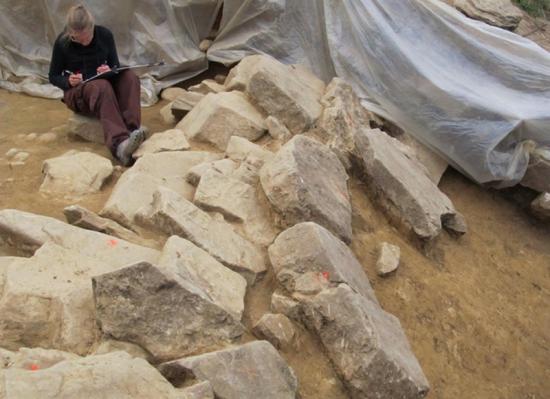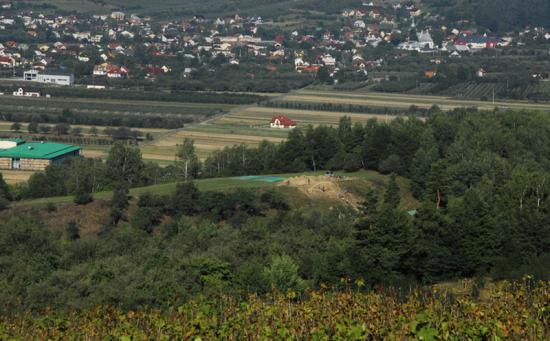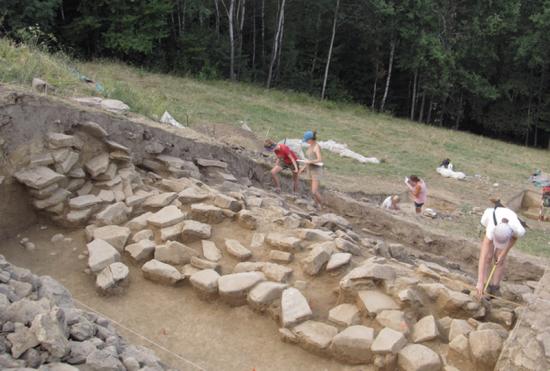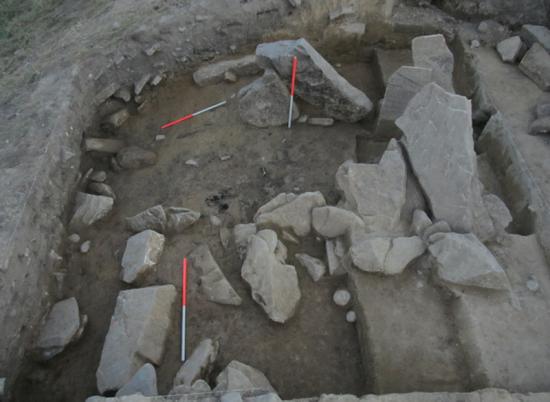Source -http://www.pasthorizonspr.com/index.php/archives/09/2015/archaeologists-discover-earliest-known-stone-wall-in-poland
Materials for this article provided by Institute of Archaeology of the Jagiellonian University (article in Polish written by Dr Marcin S. Przybyła, Excavation Director)
 Recording the large stone blocks that form the outer wall face. Image: M.S. Przybyła
Recording the large stone blocks that form the outer wall face. Image: M.S. Przybyła
Góra Zyndrama (Zyndram Hill) in Maszkowice (southern Poland) has been known as an archaeological site since the early 20th century. The first excavations were carried out between 1959-1975, when a well-preserved prehistoric settlement was discovered. The village was inhabited over a period spanning roughly 1000-50 BC. In 2010, an expedition from the Institute of Archaeology, Jagiellonian University, begun excavating an area of the site which hadn’t previously been investigated; where the upper plateau rapidly ends, passing into its eastern slope. The fieldwork which was continued in 2012 and 2014, showed that beneath the later settlement existed an earlier one.
Small group of colonists
This phase of settlement has been dated to the Early Bronze Age, populated not by the local people who had inhabited Małopolska since the Late Neolithic, but by a relatively small (150-200) group of ‘colonists’ who had arrived from the Tisa River basin to the south (an area in present-day Hungary). Several sites connected with this “non-local” southern tradition (the so-called Otomani-Füzesabony culture) were already known in the Polish Carpathians, with the most famous example at the fortified settlement of Trzcinica near Jasło – known as the ‘Troy of the North’.
 View of the area of archaeological work on Zyndram Hill. Image: A. Maślak
View of the area of archaeological work on Zyndram Hill. Image: A. Maślak
These new settlers levelled the entire hilltop, creating a plateau of circa 5000 m2. The vast quantity of clay produced by this levelling was then used to form a terrace on the gentler eastern and northern slopes, enlarging the area of the settlement even further. The entire construction was then reinforced by a huge dry stone retaining wall built of large sandstone blocks bonded with clay. Geomagnetic surveys have revealed that this wall continued for around 120-140 metres, surrounding the settlement to the east and north, acting not only as a retaining wall but also as a defensive fortification standing up to 3m high.
Construction typical of the Mediterranean world
It is this aspect of the Maszkowice settlement that makes it particularly interesting for today’s researchers, as there are fewer than twenty sites of such an early date in the whole of Central Europe that can boast intact stone fortifications. During the Early Bronze Age in this region, the use of stone as a construction material was typical of the Mediterranean world, while in the temperate zone of Europe, they were usually erected from timber and earth – a practice that continued up to the medieval period.
Intrigued by this, the team decided to suspend exploration of the settlement’s interior and open new trenches downhill, focusing the 2015 campaign on a comprehensive investigation of the terrace’s stone revetment. The observations made during the first three weeks of exploration confirmed previous findings but then, they came across something absolutely unexpected.
After removing the later deposits covering the retaining wall from the downslope side, they began to uncover the outer face of the wall built of massive, close-fitting sandstone blocks measuring from 70 cm – 1 metre in size. Rather than the irregular blocks that formed the inner face of the wall, the outer face contained many that were dressed to form rough hexagons. 4-5 courses of these stones were still tightly bonded and survived in situ to a total height of up to 1 m. Taking into account the height of the terrace and the number of sandstone blocks that were discovered beneath it (which must have tumbled from the wall), it is reasonable to assume that the original revetment reached 3m in height.
 View of excavation showing the clay terrace and Early Bronze Age stone constructions. Image: M.S. Przybyła
View of excavation showing the clay terrace and Early Bronze Age stone constructions. Image: M.S. Przybyła
A Gateway passage
Another element of the defensive system was found a further 5m down the slope, in the form of a 1.50 m deep, narrow trench with steep sides and a flat base (its dating has not yet been finally determined). In addition – while exploring the revetment, the remains of an entrance gateway was discovered consisting of a narrow (1.30m) passage through the wall, leading upwards through the clay embankment towards the interior of the settlement. The walls of this gateway passage were faced with large sandstone slabs “anchored” in the lowermost layer of blocks forming the retaining wall. Though now leaning slightly, these slabs still stand where they were fixed more than 3,500 years ago.
 View of stone slabs defining a passage leading to the interior settlement. Image: M.S. Przybyła
View of stone slabs defining a passage leading to the interior settlement. Image: M.S. Przybyła
Oldest known example of a stone wall in Poland
The monumentality of the stone architecture erected between 1750 and 1690 BCE (radiocarbon dates for the deposits contemporary to the construction of the walls) makes the fortifications at Zyndram Hill the oldest known example of a stone wall in Poland. The scale of the entire complex and the size of blocks used in the construction places this architecture much closer to that known from the Bronze Age civilisations of the Mediterranean world than to any cultural tradition of Central or Western Europe. The fact that all of the Maszkowice fortifications were erected immediately after the arrival of the people who founded this first settlement speaks of the organisation and skills that this group brought with them, which enabled them to successfully use stone as a construction material.
There are strong indications that this knowledge was derived from the South European tradition, where stone architecture had been developing since the beginnings of the Bronze Age. This southern contact has already been suggested by a fragment of a stylised anthropomorphic figurine, known as ‘violin idols‘, discovered in 2011 in a layer dated to around 1500 BC. Such figurines were manufactured in large numbers in Mycenaean Greece and the northern Balkans, and most likely represented a female deity.